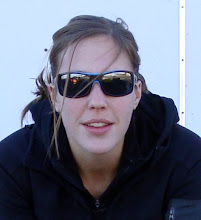Bitter Sweet Brimstone
 We've tried twice now to get to our most northern helicopter supported field site, known as Brimstone Peak. Unforutnately, because it is so far north, it is difficult to know what site conditions will be without actually flying out there. So far, we've given it two shots, and both times we've had to turn back. This is the bitter part of the equation. Look above, and you'll see the sweet factor. Paul has flown us both times, and both flights we've been lucky enough to see some incredible features on the return flight back. That deep, vibrant blue is a chunk of submerged iceberg. I honestly do not think I have ever seen such a color occur naturally. I was a giddy fool when I saw this berg. There's a close up of it below. Seriously??? Unbelievable.
We've tried twice now to get to our most northern helicopter supported field site, known as Brimstone Peak. Unforutnately, because it is so far north, it is difficult to know what site conditions will be without actually flying out there. So far, we've given it two shots, and both times we've had to turn back. This is the bitter part of the equation. Look above, and you'll see the sweet factor. Paul has flown us both times, and both flights we've been lucky enough to see some incredible features on the return flight back. That deep, vibrant blue is a chunk of submerged iceberg. I honestly do not think I have ever seen such a color occur naturally. I was a giddy fool when I saw this berg. There's a close up of it below. Seriously??? Unbelievable. All of these photos are from our first attempt at reaching Brimstone. The weather forecast said it was clear, but we soon found out that the site was completely socked it. It was quite a surreal thing actually, I've never seen Antarctic weather like it before. The sky was gray, almost purple, and there were pockets on the horizon where it looked like it was raining. I think this strange lighting helped to make all of the views so stunning. Below are just a handful of photos from that night.
All of these photos are from our first attempt at reaching Brimstone. The weather forecast said it was clear, but we soon found out that the site was completely socked it. It was quite a surreal thing actually, I've never seen Antarctic weather like it before. The sky was gray, almost purple, and there were pockets on the horizon where it looked like it was raining. I think this strange lighting helped to make all of the views so stunning. Below are just a handful of photos from that night. 


Penguinos!!!!

I've literally got dozens of photos like the one above. The helicopters we fly can't go over water, but we got to fly back along the sea ice edge because of where we had to turn around when the weather went bad. It was an experience of a lifetime, and I will not soon forget it.



 ***OK, don't pay attention to dates. I hate that blogger doesn't keep things in order (they don't keep the first entry at the top so you can read through in a logical order) so I fudge the dates to make them show up correct.***
***OK, don't pay attention to dates. I hate that blogger doesn't keep things in order (they don't keep the first entry at the top so you can read through in a logical order) so I fudge the dates to make them show up correct.***  Because we wanted to collect at least 2 hours of data to get a good tie, we ended up having some time to look around. Mt.
Because we wanted to collect at least 2 hours of data to get a good tie, we ended up having some time to look around. Mt. 

